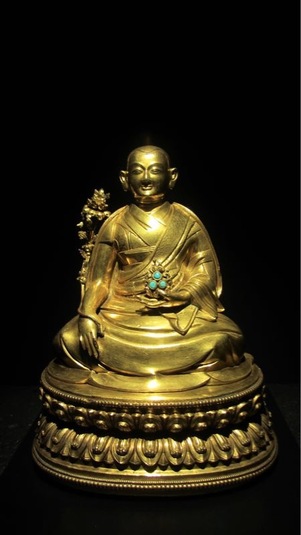
Item: Teacher (Lama) - Ngagwang Trinle Gyatso
| Origin Location | Tibet |
|---|---|
| Date Range | 1700 - 1799 |
| Lineages | Gelug and Buddhist |
| Material | Metal, Mercuric Gild, Stone Inset: Turquoise |
| Collection | Private |
Classification: Person
Appearance: Monastic
Gender: Male
Ngagwang Trinle Gyatso, the 2nd Rongpo Drubchen (1678-1739 [TBRC P409]). Later in life he was given the title Dechen Chokyi Gyalpo as inscribed in Tibetan writing on the base of this sculpture.
Somewhat youthful in appearance, Ngagwang Trinle Gyatso was born in Rebkong, Qinghai Province of China. He belonged to the Gelug Tradition of Tibetan Buddhism. In this sculptural portrait he has a slight smile and a non receding hairline. The eyes are neither partially closed as if in meditation nor fully open. The right hand is extended across the right knee gently holding with the thumb the stem of a flower blossoming over his right shoulder. The left hand placed palm up in the lap holds a flaming wish-fulfilling jewel with three turquoise inset stones symbolizing the Three Jewels of Buddhism; the Enlightened one, the teaching and the monastic community (Buddha, Dharma and Sangha). Wearing monastic robes in the typical patchwork fashion, he also wears a monk’s shirt popularized in the 16th century identified by the rectangular lappets covering the top of the shoulder. This type of shirt is of Tibetan origin and not found in the Vinaya texts of early Buddhism. Covering the back and surrounding the robes and then folded over the legs is a meditation cloak, another creation of Tibetan monastic invention.
Seated in a cross legged posture, with the fabric robes spilling to the sides, he is well poised above a double lotus cushioned seat. The upper part of the lotus is ringed with a series of beads in imitation of pistils and stamins. The lower base is ringed with two sets of beads one larger than the other. The lotus petals are well defined and detailed reminiscent of the fine Yongle style sculptural lotus base of two centuries earlier.
The gold gilt sculpture is in fine condition with little wear, scratches or loss of gilding. An inscription on the back of the lotus base identifies the figure as Dechen Chokyi Gyalpo, an epithet, but it is not dated and with no reference to an artist or donor. The inscription begins with ‘left 11th’ which means that this sculpture belonged to a set of works depicting some type of lineage, a series of teachers. Dechen Gyalpo would be the 23rd teacher in the lineage.
The sculpture can be dated to a time after the death of Ngagwang Trinle Gyatso evidenced by the wish-fulfilling jewel in the hand rather than the typical long-life vase used when a person is still living. Also, if still living the figure would typically be placed on two or three stacked rectangular cushions rather than on the lotus which can indicate the passing and subsequent rebirth in a heaven or pureland of a Buddha such as Amitabha’s Western Paradise. Stylistically the work is a fine art sculpture of the 18th century, likely mid century. Further, the sculpture would belong to a set, possibly of an incarnation lineage or possibly the abbots of an important monastery, or some such series of teachers popular during the 18th century.
Jeff Watt 6-2018
Sothebys, New York. March, 1997. (See HAR #10865).
Tibetan Printed Script (Uchen)
English Transliteration: Left 11th. Dechen Chokyi Gyalpo.
Collection of Zhiguan Museum (Teachers)
Collection of Zhiguan (Sculpture)
Tradition: Gelug Tradition Main Page
Tibet: Amdo (East Tibet)
Collection of Zhiguan Museum of Fine Art
Teacher: Rongpo Ngagwang Trinle Gyatso
Teacher: Late Period Sculpture (17th - Present)

